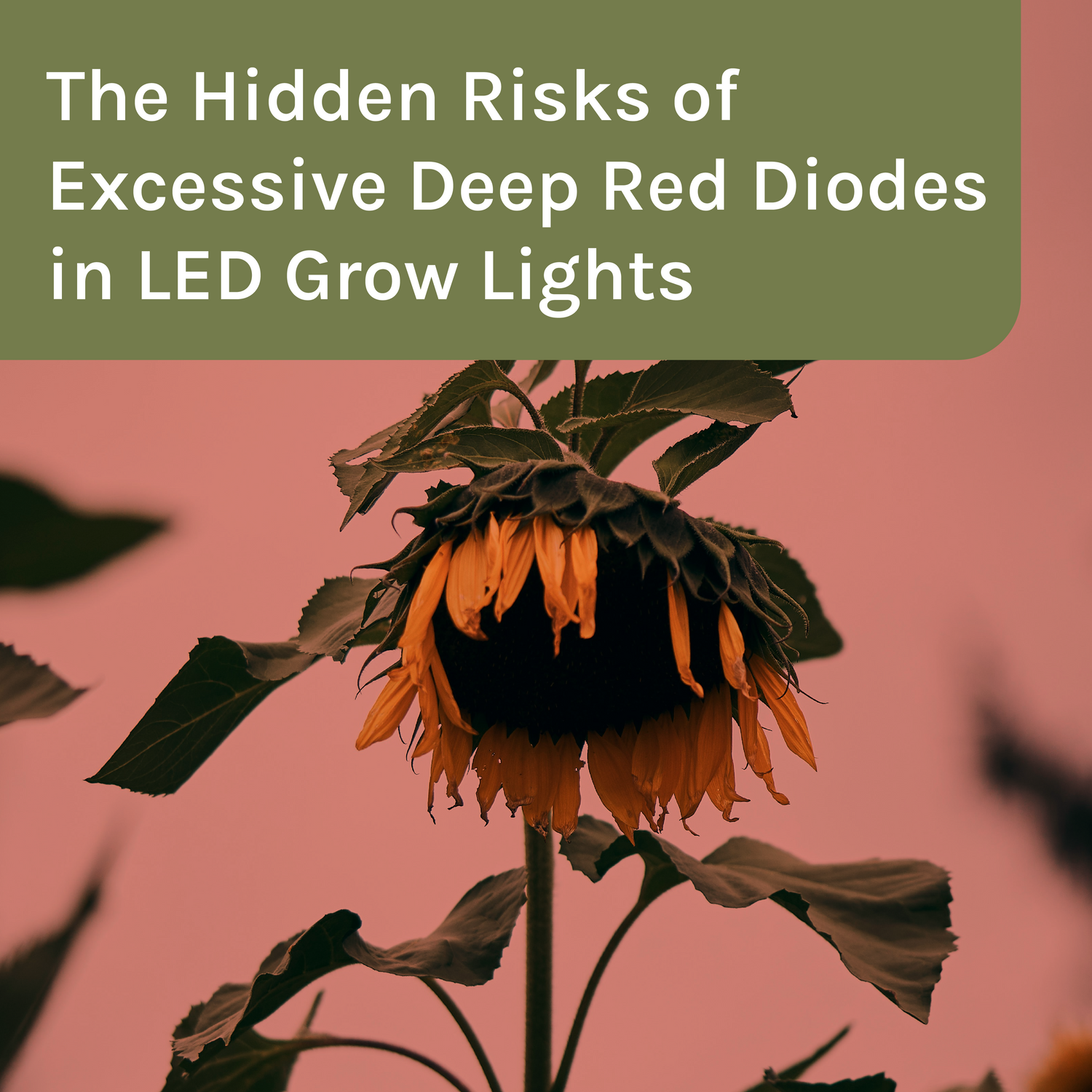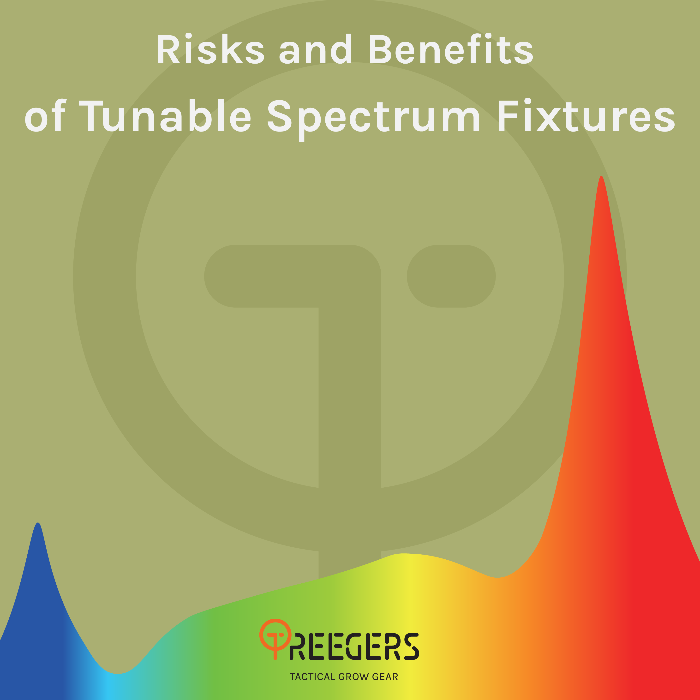LED Büyüme Işıklarındaki Aşırı Derin Kırmızı Diyotların Gizli Riskleri
Derin kırmızı ışık (660nm), yüksek performanslı tarımsal aydınlatmanın önemli bir bileşenidir.
Fotosentezi verimli bir şekilde destekler, çiçeklenmeyi artırır ve biyokütle üretimine katkıda bulunur. Ancak, fazlası her zaman daha iyi değildir. Aşırı miktarda derin kırmızı diyotla donatılmış LED armatürler, bitki morfolojisini, ışık dağılımını, stres tepkisini ve genel verimi olumsuz etkileyebilir. Treegers olarak, spektral tasarımda bilimsel temelli bir yaklaşım benimsiyoruz. 660nm derin kırmızı, 4000K beyaz ve 5000K beyaz diyotların dikkatle kalibre edilmiş bir kombinasyonunu kullanarak dengeli, tam spektrumlu bir ışık sunuyoruz—aşırı derin kırmızı diyot kullanımının riskleri olmadan. Şimdi neden çok fazla derin kırmızı ışığın sorun yaratabileceğine ve optimize edilmiş spektrumun nasıl daha sağlıklı bitkilere ve daha yüksek verime yol açtığına bakalım.
Bitki Gelişiminde Derin Kırmızının Rolü
Derin kırmızı ışık (660nm), fotosentez için en verimli dalga boylarından biridir. Klorofilin emilim zirveleriyle doğrudan hizalanır ve bitkilerde enerji dönüşümünün temel itici gücüdür. Ayrıca, çiçeklenme, çimlenme ve gölge kaçınma gibi süreçleri düzenleyen fitokrom aktivitelerini etkiler. Bu güçlü etkileri nedeniyle, derin kırmızının doğru şekilde entegre edilmesi şarttır. Ancak spektrumda aşırı doygunluk oluşursa, istenmeyen sonuçlar ortaya çıkabilir.
LED Armatürlerde Aşırı Derin Kırmızının Riskleri
Derin kırmızı ışık faydalı olsa da, aşırı sayıda 660nm diyot içeren dengesiz bir spektrum, kontrollü ortam tarımında çeşitli sorunlara yol açabilir:
a) Aşırı Uzama ve Zayıf Gövde Gelişimi: Fazla derin kırmızı ışık, bitkilerde gölge kaçınma tepkisini tetikler ve bu da aşırı uzamaya neden olur. Sonuç olarak daha uzun ama zayıf gövdeler gelişir ve özellikle yoğun ekim yapılan alanlarda devrilme riski artar.
b) Mavi Işık Desteği Eksikliği: Derin kırmızı, mavi ve geniş spektrumlu beyaz ışıkla dengelenmelidir. Yeterli mavi dalga boyları (400–500nm) olmadan, bitkiler uzun boğum aralıkları, ince yapraklar ve düşük stres toleransı gösterebilir. Treegers, 4000K ve 5000K beyaz diyotları entegre ederek bu eksikliği giderir; böylece güçlü, kompakt bitki yapısı ve tam spektrum avantajı sağlanır.
c) Düzensiz Işık Dağılımı ve Taç Yapraklara Nüfuz Sorunları: Derin kırmızı ışığın yayılma açısı, geniş spektrumlu beyaz ışığa göre daha dardır. Aşırı derin kırmızı içeren armatürler sıcak noktalar ve düzensiz ışık dağılımı yaratabilir; bu da alt taç yapraklarında yetersiz gelişime yol açar. Treegers armatürleri, tüm yetiştirme alanı boyunca tutarlı PPFD düzeyleri sağlayacak şekilde tasarlanmıştır.
d) Artan Bitki Stresi ve Hassasiyet: Aşırı derin kırmızı, bitki homeostazını bozabilir ve çevresel stres etmenlerine karşı duyarlılığı artırabilir. 660nm diyot fazlalığı:
-
Transpirasyon oranlarını değiştirerek ısı stresine yatkınlığı artırabilir.
-
Su tüketimini artırarak besin alımında dengesizlik yaratabilir.
-
Bitki savunma sistemlerini zayıflatabilir, zararlılar ve hastalıklara karşı direnci azaltabilir.
Dengeli bir spektrum, bitkide gereksiz stres oluşmasını engeller, stabil büyümeyi ve yüksek kaliteli verimi garanti eder.
e) Yüksek Isı Üretimi ve Daha Hızlı LED Aşınması: Derin kırmızı diyotlar, beyaz diyotlara göre daha yüksek sıcaklıklarda çalışır. Derin kırmızıya aşırı bağımlı armatürler:
-
Isı üretimini artırarak bitki sıcaklık dengesini bozabilir,
-
Diyot ömrünü kısaltarak armatür verimliliğini azaltabilir.
Treegers’ın gelişmiş termal yönetimi, aşırı ısı oluşumunu önleyerek uzun ömürlü ve kararlı performans sağlar.
Treegers Yaklaşımı: Bilim Temelli Tam Spektrum
Treegers, armatürlerini aşırı derin kırmızı diyotlarla doldurmak yerine dengeli bir tam spektrum yaklaşımıyla tasarlamıştır:
-
Fotosentez ve çiçeklenmeyi desteklemek için 660nm derin kırmızı,
-
Güçlü morfoloji ve stres direnci sağlayan mavi ağırlıklı 4000K & 5000K beyaz diyotlar,
-
Üstün ışık dağılımı, uniformluk ve verimlilik için hassas mühendislik.
Aşırı derin kırmızı seviyeleri sunan bazı LED üreticilerinin aksine, Treegers, mükemmel şekilde ayarlanmış spektral dengeyi sağlar—daha yüksek kaliteli verim, ideal bitki yapısı ve uzun vadeli armatür güvenilirliği sunar.
Sonuç
Derin kırmızı ışık bitki büyümesi için hayati öneme sahiptir, ancak fazlası faydadan çok zarar getirebilir. Etkili LED aydınlatmanın anahtarı, spektrum dengesidir—güçlü morfoloji, verimli enerji kullanımı ve uzun vadeli stabilite sağlar. Treegers’ın bilimsel olarak optimize edilmiş tam spektrumlu armatürleri, spektral dengesizlik riskleri olmadan, derin kırmızı ile geniş spektrumlu beyaz ışığın ideal dengesini sunar.





